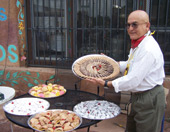At 200 feet, it’s startlingly quiet. Shortly before 8 a.m., during Albuquerque’s rush hour, you can see roads below packed with vehicles. But when you float in a hot-air balloon 200 feet off the ground, the din of traffic is barely audible. What you do hear is the stillness of the air, punctuated occasionally by the roar of the flame that heats the air in the balloon over your head.
Albuquerque and the areas that surround it exemplify the typical beauty of the American Southwest. From a hot-air balloon, you can see the Rio Grande cutting a serpentine path through the brush-dotted, arid desert landscape. The green peaks of the Sandia Mountains linger in the distance.
It’s this natural beauty and a rich, colorful blend of Hispanic and indigenous cultures that make New Mexico a fascinating place to visit. I explored the city and countryside from in the air and on the ground during a five-day trip last fall.
Bird’s-eye view
I was only one of thousands of people to float above Albuquerque last year. The city has become famous for its annual International Balloon Fiesta, which draws about 700 balloons and 700,000 spectators to the area each October. During the event, the skies above the city are filled with brightly colored balloons; throughout the rest of the year, you’ll see balloons dotting the horizon during the early morning hours as well, taking visitors and tourists up for a bird’s-eye view.
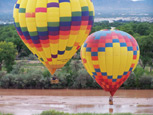 |
| Rainbow Ryders Hot Air Balloon Co. provides regular rides for visitors. By Brian Jewell |
Early on my first morning in Albuquerque, I went with some other visitors on a flight with the Rainbow Ryders Hot Air Balloon Co. and pilot Randy Johnson. As we floated, Johnson told us about the physics of the hot-air balloon flight and the natural characteristics that make Albuquerque such a special place for balloon enthusiasts.
“The wind is going in different directions and different altitudes, so if you change your altitude, you change your direction,” he said. “The reason why ballooning is so popular here is that we have more air thermals and more open space than anywhere else in the world.”
Ballooning is such a big deal in Albuquerque that the city has a museum dedicated to the sport’s history in the area. So after landing, I paid a visit to the Anderson-Abruzzo Albuquerque International Balloon Museum, which has hundreds of exhibits and artifacts celebrating the sport.
Displays at the museum cover a range of subjects, from the development and evolution of balloon fabrics to different ways that the military has used hot-air balloons since the time of the Civil War. Highlights of the collection include the first manned balloon to cross the Pacific Ocean and a hyperbaric chamber used by late balloon pioneer Steven Fosset to acclimate himself to low air pressure.
A simulator at the museum lets visitors try their hand at launching, steering and landing a hot-air balloon.
Relics in the desert
The large-scale views of the New Mexico desert are fascinating from above, and they’re even more interesting in detail on the ground. Later in the trip, I took an excursion into the desert areas outside the city with New Mexico Jeep Tours.
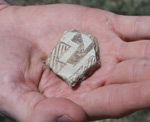 |
| Painted pottery shards found on a Jeep tour of the desert are reminders of the state’s pre-Hispanic civilization. By Brian Jewell |
|
One of my favorite things about visiting New Mexico is its cuisine. Food throughout the state bears many similarities to traditional Mexican food from south of the border but also features some distinct flavors and customs all its own. From red and green chili sauces to the mild and sweet biscochito cookies, I got my fill of great food in Albuquerque. At Blue Plate Special, a local catering company, groups can take cooking classes with owners and catering chefs Scott and Gwen Clapp, who have been teaching guests how to prepare Southwestern cuisine since 2001. I stopped in for one of their hands-on classes, joining a small group of other students in learning how to prepare chili rellenos, stacked enchiladas and other traditional New Mexican dishes. As we sliced cheese, boiled chicken and stuffed peppers, Scott told us about the history of the food we were preparing and explained how capsaicin — the chemical in peppers that produces the hot feeling in your mouth — affects your taste over time. “Capsaicin is addictive, and as you eat it, you build up a tolerance to it,” he said. “So asking a New Mexican person if something is spicy isn’t likely to be very helpful.” The next day, I paid a visit to Golden Crown Bakery, where a father-son team has been preparing traditional New Mexican breads and pastries for years. One of their specialties is the biscochito, a small Mexican-style shortbread cookie that is sprinkled with sugar and cinnamon. During the Christmas season, owner Pratt Morales and his son sell more than 12,000 of these cookies each day. Pratt shared his secret to what makes his biscochitos and other dishes so popular. “Our food is nutritious, delicious and beautiful,” he said. “It has to be beautiful. If it doesn’t look beautiful to your eyes, you’re not going to eat it.” |
During the full-day tour, other participants and I rode along in red Jeeps with the tops rolled down. Our drivers took us into wilderness areas that were formed by volcanic activity and that are bordered by the Sandia Mountains. Besides taking in the scenery, we visited a number of sites with ruins of pre-Hispanic civilizations that thrived in the area centuries ago.
At one place — a “secret location,” according to our guide — we found numerous Indian artifacts, including painted pottery shards and three arrowheads. The guide estimated that the items date back to A.D. 600-1200. We held the objects in our hands, admiring their age and beauty, and then put them back for the next group of adventurers to discover.
To learn more about the indigenous people who lived in this area before us, I visited Petroglyph National Monument. Between 1300 and 1650, the ancestors of the Pueblo Indians left more than 2,000 line drawings carved into the rocks of the 17-square-mile area.
Chief of interpretation Diane Souder led me around the monument, which is now part of the national park system.
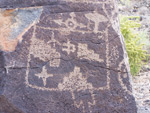 |
| Petroglyph National Monument preserves line drawings indigenous people carved into basalt rocks hundreds of years ago. By Brian Jewell |
“To the Pueblo people, this is a sacred place,” she said. “We don’t really know what a lot of the images mean. But we do know that they were sacred images, and they continue to be important to the Pueblo people.”
Experts believe that the Pueblos’ ancestors used stone tools to carve their images into the black basalt rock, likely as part of a spiritual ritual. Archaeologists continue to work and uncover new treasures at the monument. There are about 350 active archaeological sites at Petroglyph, among them a 1,100-room adobe pueblo that has yet to be excavated.
Exploring ethnicity
The people who carved the petroglyphs were ancestors of the natives living in the area when Spanish explorers arrived in the 16th century. The Spanish encountered numerous groups of these people throughout the area and named them “puebelos,” which is Spanish for “villages.” Today, there are 19 Native American pueblos in New Mexico, and the groups are known collectively as the Pueblo people.
To learn more about these people, I visited Albuquerque’s Indian Pueblo Cultural Center for an overview of native art, history and culture. The museum at the center has exhibits on the languages of each pueblo and on each pueblo’s first contact with European explorers. Artifacts on display include clothing, household tools and ceremonial items.
One of the highlights of the museum is its fine-art gallery, which displays a wide range of pottery and other artwork created by the Pueblo people. Walking through the exhibit, I began to notice some of the interesting artistic touches and techniques that distinguished the artwork of each pueblo.
 |
| The National Hispanic Cultural Center puts on more than 600 programs a year to demonstrate the Hispanic culture of New Mexico. Courtesy National Hispanic Cultural Center |
After the Spanish settled in the area, they began to intermarry with the natives, creating a mestizo, or “mixed” race. This Hispanic heritage soon became one of the predominant cultural influences of the Southwest. New Mexico visitors can learn more about this group at the National Hispanic Cultural Center.
“We’re the largest Hispanic or Latino center in the country,” said marketing and public relations director Danny Lopez as he showed me around the center. “We’ve put on over 600 programs. Last year, we had 200,000 people come through.”
The cultural center’s museum has a collection of 2,500 pieces of historic and contemporary art produced by Hispanics in New Mexico. Hispanic Heritage is displayed in the architecture of the building as well.
One of the most interesting aspects of the museum is a work in progress. Inside a 45-foot tower on the property, a local Hispanic artist is painting a 360-degree wall and ceiling mural depicting New Mexico’s Hispanic history. The painting will take several years to complete, but visitors can stop in to see the progress and talk to the painter. Once it’s finished, the work will be the largest concave fresco in the United States.
Old Town art
All of these cultural and historic elements come together in Albuquerque’s Old Town, a historic district downtown where the city was originally established in 1706 on the banks of the Rio Grande.
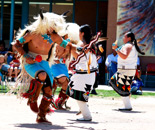 |
| The Indian Pueblo Cultural Center provides an overview of New Mexico’s native art, history and culture and includes demonstrations of Pueblo Indian dances. Courtesy Indian Pueblo Cultural Center |
Though three centuries have passed since the settlement was established, Old Town still resembles a colonial settlement. The area was planned in traditional Spanish style, with a central public plaza and church surrounded by homes and businesses. Many buildings in the plaza are examples of the adobe architecture that was widely used throughout the historic Southwest and that continues to be a popular style.
Today, Old Town is a vibrant commercial district where many visitors and locals come together for shopping and dining. The plaza is filled with local merchants, clothing boutiques, jewelry makers and more than 25 art galleries. Vendors on the sidewalks offer an array of handcrafts made by local Pueblo people.
It’s as ideal a place as any to end a visit to Albuquerque, resting with a plate of chili verde, enjoying the ethnic traditions around you and marveling at the desert scenery.
Travel Planning Assets
Albuquerque
Convention and Visitors Bureau
www.itsatrip.org
(800) 733-9918




